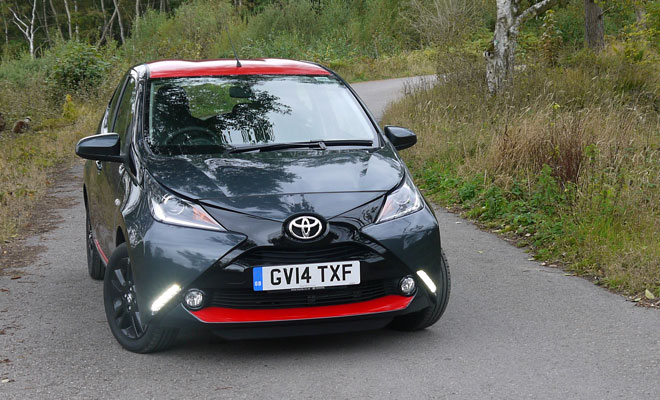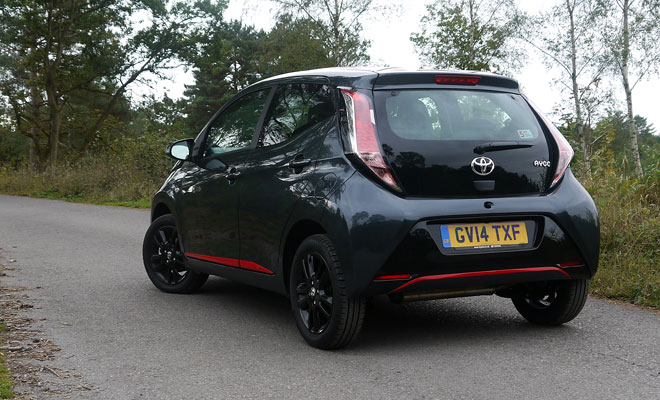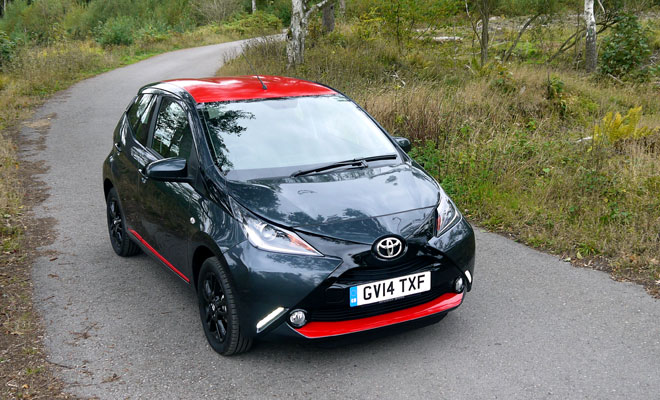by Lem Bingley 
Arguably the problem lies in my ham-fisted feet, but for the moment I’m blaming the clutch as I crouch low behind the dashboard and hide. The clutch and the throttle are at fault. And the gravel.
The clutch’s problem is that I can feel no discernible biting point. The pedal has all the tactile qualities of a garden gate, swinging idly through the point where the little 1.0-litre, three-cylinder petrol engine suddenly coughs and dies without warning. The accelerator is no help either, offering what feels like a millimetre of travel between murmur and bellow.

So I have no choice but to sidestep subtlety. The exhaust barks, the front tyres dig holes and I depart in a shower of pinging pebbles, swivelled heads and rolled eyes. I’m off to go fun myself.
A few miles later, whipping the stubby lever through its rubbery gate, I’m finally getting the hang of the Aygo. In keeping with the lairy exterior, which might as well be hanging its tongue out Miley Cyrus fashion, the Aygo needs to be driven with no discernible subtlety whatsoever. Clod-hopping feet, heavy-hand limbs, and never mind the rasping racket from the car’s arse. This is not a quiet car.

It’s also not a powerful car. Today’s creased graphite bodywork might bring to mind Batman’s rocket-powered Tumbler, but there the resemblance ends. Climb a steep hill and you’ll wonder if the Joker might have stuffed a banana up the tailpipe. The Peugeot 108 and Citroen C1, which share most lumps of metalwork with the Agyo under its chopped and chiselled skin, offer the option of 68 or 80 horsepower engines, but the Toyota comes only with the lower of the two figures. Together with a peak of 95Nm, the Aygo poses little threat to rice puddings. Still, at least it’s economical, with a CO2 output rated at 95g/km. Lower if you opt for stop-start.
Getting to 62mph takes 14.2 seconds, so it demands patience to get up to speed. The car’s X-shaped nose seems keen on corners, but the jiggly ride and darty feel make me back off instinctively on what might otherwise be a fun-filled country road. It’s hard to escape the impression I’m barrelling along in a flimsy concoction of tin-plate and plastic. The brakes aren’t bad, but the little 800kg Toyota seems unlikely to win an argument with another car, a sturdy tree or a stout, unwary badger.

That fragile feel is not accurate, thankfully. Euro NCAP gave the Aygo a solid four stars after flinging it about a bit, which is one more star than I’d have guessed. A full five stars are quite tough to acquire these days, under the current Euro NCAP assessment regime, as the equally four-star BMW i3 can attest. As cramped city cars go, the Aygo can’t be bad from a safety standpoint.
I can only assume money spent on robust crash structures left little for the interior budget, however. The cabin is a place of few frills and plenty of plastic. The seats look horrible but feel OK, as long as you’re sitting in the front. Rear passengers get little legroom, not much headroom, and windows that pop out rather than wind down.

The Aygo has recently acquired the option of an electrically folding fabric roof, previously enjoyed only by the car’s 108 and C1 siblings. Available only to those who opt for the top x-pression trim level, the “x-wave” roof costs an extra £895. That is quite a chunk of cash, but it’s an option that will transform the appeal of the car.
The roof opens and closes reasonably rapidly, even at motorway speeds, offering infinite headroom at the expense of a fair amount of buffeting. Closed, the car should be as quiet as the tin-top – so not very quiet at all.

Prices for the entry level, 3-door Aygo in “x” trim start at just £7,995. For that you’ll get 14-inch steel wheels and an overwhelming sensation of missing out. You will still get dazzling LED daylight lamps, however. At the other extreme, an Aygo in x-clusiv trim will start at £11,295, for which you’ll receive 15-inch alloys and a lingering feeling that you should probably have spent the money on something else.
Can you fun yourself in an Aygo? Kind of. It looks sharp, sounds sporty and is reasonably cheap to run. But it’s also slow, bouncy and more than a bit numb to drive. Nice try Toyota, but no cigarillo.


Toyota Aygo
Rating: stars
Good: quirky styling, low CO2, surprisingly safe
Bad: numb controls, flimsy feel, very slow
Price: from £7,995
Judging by all the adverts advising me to “go fun myself”, the Toyota Aygo ought to be a scream. But my first few moments behind the wheel are anything but jolly. Task number one is not going well. The little hatchback has been left parked nose-up on the gentle slope of a gravel car park, flanked by bigger, shinier, sportier, more powerful and considerably more pricey cars. Many motoring journalists are milling about. And I’ve just stalled. Twice. Rating: stars
Good: quirky styling, low CO2, surprisingly safe
Bad: numb controls, flimsy feel, very slow
Price: from £7,995
Arguably the problem lies in my ham-fisted feet, but for the moment I’m blaming the clutch as I crouch low behind the dashboard and hide. The clutch and the throttle are at fault. And the gravel.
The clutch’s problem is that I can feel no discernible biting point. The pedal has all the tactile qualities of a garden gate, swinging idly through the point where the little 1.0-litre, three-cylinder petrol engine suddenly coughs and dies without warning. The accelerator is no help either, offering what feels like a millimetre of travel between murmur and bellow.

So I have no choice but to sidestep subtlety. The exhaust barks, the front tyres dig holes and I depart in a shower of pinging pebbles, swivelled heads and rolled eyes. I’m off to go fun myself.
A few miles later, whipping the stubby lever through its rubbery gate, I’m finally getting the hang of the Aygo. In keeping with the lairy exterior, which might as well be hanging its tongue out Miley Cyrus fashion, the Aygo needs to be driven with no discernible subtlety whatsoever. Clod-hopping feet, heavy-hand limbs, and never mind the rasping racket from the car’s arse. This is not a quiet car.

It’s also not a powerful car. Today’s creased graphite bodywork might bring to mind Batman’s rocket-powered Tumbler, but there the resemblance ends. Climb a steep hill and you’ll wonder if the Joker might have stuffed a banana up the tailpipe. The Peugeot 108 and Citroen C1, which share most lumps of metalwork with the Agyo under its chopped and chiselled skin, offer the option of 68 or 80 horsepower engines, but the Toyota comes only with the lower of the two figures. Together with a peak of 95Nm, the Aygo poses little threat to rice puddings. Still, at least it’s economical, with a CO2 output rated at 95g/km. Lower if you opt for stop-start.
Getting to 62mph takes 14.2 seconds, so it demands patience to get up to speed. The car’s X-shaped nose seems keen on corners, but the jiggly ride and darty feel make me back off instinctively on what might otherwise be a fun-filled country road. It’s hard to escape the impression I’m barrelling along in a flimsy concoction of tin-plate and plastic. The brakes aren’t bad, but the little 800kg Toyota seems unlikely to win an argument with another car, a sturdy tree or a stout, unwary badger.

That fragile feel is not accurate, thankfully. Euro NCAP gave the Aygo a solid four stars after flinging it about a bit, which is one more star than I’d have guessed. A full five stars are quite tough to acquire these days, under the current Euro NCAP assessment regime, as the equally four-star BMW i3 can attest. As cramped city cars go, the Aygo can’t be bad from a safety standpoint.
I can only assume money spent on robust crash structures left little for the interior budget, however. The cabin is a place of few frills and plenty of plastic. The seats look horrible but feel OK, as long as you’re sitting in the front. Rear passengers get little legroom, not much headroom, and windows that pop out rather than wind down.

The Aygo has recently acquired the option of an electrically folding fabric roof, previously enjoyed only by the car’s 108 and C1 siblings. Available only to those who opt for the top x-pression trim level, the “x-wave” roof costs an extra £895. That is quite a chunk of cash, but it’s an option that will transform the appeal of the car.
The roof opens and closes reasonably rapidly, even at motorway speeds, offering infinite headroom at the expense of a fair amount of buffeting. Closed, the car should be as quiet as the tin-top – so not very quiet at all.

Prices for the entry level, 3-door Aygo in “x” trim start at just £7,995. For that you’ll get 14-inch steel wheels and an overwhelming sensation of missing out. You will still get dazzling LED daylight lamps, however. At the other extreme, an Aygo in x-clusiv trim will start at £11,295, for which you’ll receive 15-inch alloys and a lingering feeling that you should probably have spent the money on something else.
Can you fun yourself in an Aygo? Kind of. It looks sharp, sounds sporty and is reasonably cheap to run. But it’s also slow, bouncy and more than a bit numb to drive. Nice try Toyota, but no cigarillo.




